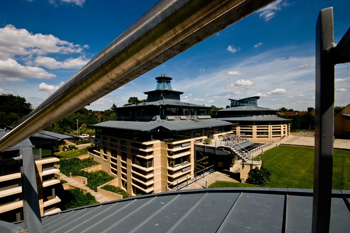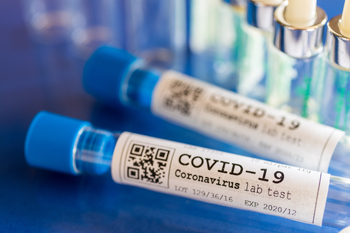
There's been a lot of focus on the re-opening of schools lately, but there's another pandemic challenge just around the corner: this month and next, universities around the country are starting their autumn terms.

What is the academic year 2020/2021 going to look like?
In normal times this would involve around two million university students migrating across the country to their institution of choice. As you might imagine, and as we know from the "freshers flu", infections can spread quite easily around a university campus. With COVID-19 there is the additional worry that young people are more likely to be asymptomatic, so that an outbreak may not be spotted as quickly as one would wish. And while young people are less likely to get seriously sick with COVID-19, students do mix with staff who may be more vulnerable, and with the surrounding community, so an epidemic at a university poses risks that can't be ignored.
So what do we know about keeping universities as safe as possible? In July two online brainstorming sessions, part of the Infectious Dynamics of Pandemics programme (IDP) put on by the Isaac Newton Institute, brought together mathematicians and representatives of the Department for Education and higher education providers to see how maths can help solve some of the problems — quickly. What mathematicians have to offer is the ability to simulate the spread of the disease under various circumstances using mathematical models. They can then see if and how mitigating measures would affect the spread.
"[We want to be] part of a multi-disciplinary tapestry of ways of looking at the problem," says Rebecca Hoyle of the University of Southampton and contributor to the IDP sessions. "It's not that we feel we have all the answers, but we are offering a part of that patchwork."
The baseline
See here for all our coverage of the COVID-19 pandemic.
The first thing to figure out in this context is how the disease would spread through a typical student population if things just carried on as normal. At the IDP meeting Ellen Brooks Pollock reported on the work of a team at the University of Bristol who did just that. To get a handle on the contact patterns of students — who meets whom and how frequently — the team used data from a social contact survey conducted in 2010, together with anonymised information about the household circumstances of Bristol students. Looking at where their students typically come from when they arrive at the start of term, the team also estimated how many of them would arrive infected with COVID-19. They built this information into a stochastic compartmental model (you can find out more about compartmental models here) which simulates the spread of a disease through a population.

The Centre for Mathematical Sciences at the University of Cambridge (home of Plus) is certain to be less busy in the new academic year.
The model suggests that around 20% of students at Bristol could be infected during the first term and, if university life carries on as normal, around 74% would be infected by the end of the academic year. Freshers would experience the highest rate of infection and would also drive the early part of the outbreak. That's unsurprising given the boundless enthusiasm for socialising you'd expect from first-years, but also because at the University of Bristol, like at many others, halls of residence, the favoured accommodation of newly arrived students, tend to be mixing pots of different subjects.
The modelling also showed, however, that much depends on just how infectious those slippery asymptomatic cases are, compared to symptomatic ones. The results above hinge on the assumption that asymptomatics are only about half as infectious as symptomatic ones, a reasonable estimate in the light of available data. But Brooks Pollock and her colleagues also tried out other values for this relative infection rate and found that the final size of the epidemic is very sensitive to that number. For example, if we assume that asymptomatic people are just as infectious as those showing symptoms, then around 96% of students would be infected by the end of the academic year.
Like all models, the one developed by the team at Bristol is based on assumptions and comes with limitations, which you can read about in this paper. However, the results confirm there's a real risk of university epidemics. They also suggest that more research into the infectiousness of asymptomatic cases is needed to better simulate those outbreaks.
Test, test, test
As we all know by now, to avoid or at least mitigate an epidemic, it's important to break the chains of infection early on. Would it make sense, therefore, for larger universities to put in place their own in-house test-and-trace system? The IDP sessions also heard from a team at the University of Warwick, who are investigating just that. The team used a compartmental model combined with networks reflecting contact patterns to simulate the spread of the disease on the Warwick campus.
Initial results reported at the IDP sessions suggest that, to be at its most effective, testing and tracing needs to operate smoothly: it's important that enough people who develop symptoms actually go and get a test, and that the delay between them getting the symptoms and the test-and-tracing system springing into action is kept short. With both of these issues an in-house test-and-trace system can obviously help.

Testing is likely to feature at some univeristies.
The only way of catching the potentially dangerous asymptomatic cases, however, is to carry out routine testing of the entire student body. The question is, how frequently would students need to be tested for such a programme to be effective? That's another problem the Bristol study considered, and the answer, according to the model, is at least every two weeks.
Scaled up to all UK universities this would mean a lot of testing, and the question is where all those tests would come from. While some universities are using their own labs to build testing capacity, most can't do this, so university testing might have to draw on national capacity currently reserved for health and care workers and people with symptoms.
Given the current problems with testing, it makes sense to also explore more economical approaches. "[We might also consider] batch testing," explains Hoyle. "The idea is to test multiple people in one go by combining their samples. If that test comes back negative you don't need to do individual tests — you only need to individually test the people who were in positive batches. So it's a way in which you might test a lot of people regularly."
Participants of the IDP sessions are now working on test and trace models, with the aim of producing an adaptive modelling tool individual institutions can use to find out what kind of testing regime is appropriate for them. Modelling will also give us more of an idea of how dangerous an epidemic at a university will be to the surrounding community. If the danger is high, then national policy should take this into account: some of the national testing capacity may indeed have to be reserved for universities.
In the meantime, institutions also need to think about what to do with students who test positive. In the models it's always assumed that those people go off into quarantine until they are no longer infectious, but reality isn't as simple as that. Telling a 20-year-old to self-isolate for two weeks in a tiny student room, far away from home, could lead to flauting of the rules or, worse, severe mental health problems. If a test happens at the end of term when everyone is expecting to go home, this would be all the worse. There is work to do not just for the modellers, but also those responsible for student welfare and support.
Testing isn't of course the only measure universities can put into place. Reducing face-to-face teaching and contacts between students are two other obvious options. You can find out more about these on the next page.
About the author
Marianne Freiberger is Editor of Plus.